It feels like a long time has passed since I last wrote about our travels. We’ve been to quite a few places in a short space of time, but have been without Internet access in most of them.
In Corme we enjoyed a long walk through a rural landscape very different to any we’ve walked in since our journey began. Just a short distance inland the air grew heavy and oppressive, and the plants, birds and insects were new to us. As the children played at a woodland playground behind a stretch of protected sand dunes we encountered our first lizard – a little lime green fellow basking in the sun on a kerb.
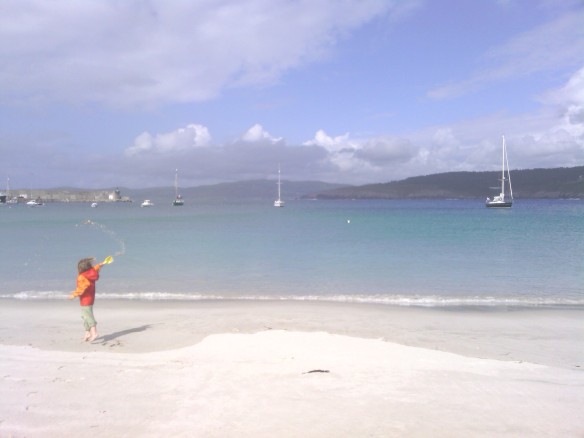
Katie on the beach at Corme
We had fun on the beach at Corme, swimming in the crystal clear water, and one evening we had a barbecue on a huge beach that we had all to ourselves. But we were constantly looking to the sky during our stay at Corme, willing the dark clouds to stay away. Alas, they never complied, and all those wet sandy clothes from days on the beach caused me no small amount of annoyance.
Most of our last twenty-four hours in Corme were bumpy and misty, until the wind changed suddenly, shortly before dawn, and all was calm and clear again.
We had a delightful sail from Corme to Ria de Camariñas, 20 miles farther along the Costa del Morte – the Coast of Death(!) – and spent the night in the Club Nautico de Camariñas – the most inexpensive marina we’ve been to…ever! Arriving into Camariñas the genoa (the large sail at the front of the boat) refused to furl and Julian had to drop it and quickly stow it in the fore cabin (Lily and Katie’s bedroom). A pin had come out of the roller furler, causing the furling mechanism to jam. Our genoa at present is folded and stuffed into the aft heads.
The Club Nautico had that same international feel as Falmouth. It was small and intimate, with yachts from the US, Australia, the UK and, of course, the Dutch and French yachts that are ubiquitous along this coast. With the genoa out of action, we considered staying in Camariñas for a few days. It was cheap, with access to fresh water, electricity, and free Wifi, and the club’s cafe/bar was only 20 metres from our boat! But the forecast suggested that if we didn’t leave the next day then we would be in for an uncomfortable few days with the wind hitting us on the pontoon or at anchor. So, despite the advantages offered by Camariñas, we spent less than 18 hours there, and were once again out on the water.
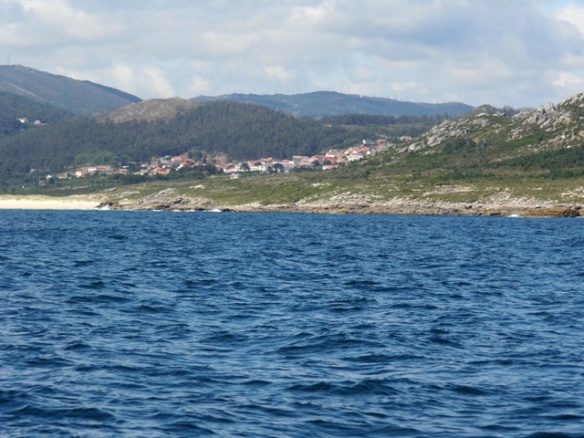
The last town on the Coast of Death!
There was no wind anyway on the next leg of our journey, so genoa or no genoa, there was no sailing to be had. We motored for six hours in dead calm, past Fisterra – the most westerly point of mainland Europe – and were, for the first time since departing Plymouth, not on a south westerly course. We were past the Costa del Morte and into the Ria de Muros.
The Ria de Muros is heavenly. The mountains are rugged, the beaches are long, golden and sandy, the water is aquamarine, and the sky is the bluest blue. Picturesque ancient towns and villages are nestled amongst the hills. These collections of white-walled, orange-roofed buildings look pretty from a distance, and once amongst them, they are warrens of narrow cobbled streets, with fountained plazas and ancient stone churches.
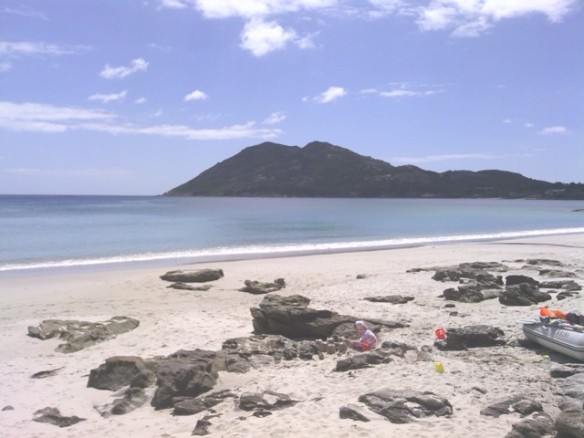
The beach at Louro
We spent our first two nights at anchor off the beach in Louro, the first very touristy town we have come to. On our first morning we rowed to shore. The girls and I spent the day on the beach, never going more than 20 metres from our dinghy, with its supplies of food, water and sunscreen. We built sandcastles and swam in the warm sea. Lily really got to grips with swimming without any buoyancy aids for the first time. The water was warm enough for her to want to stay in for a long time, and she swam her little heart out. Each time she’d say ‘Just one more try’, and I had to tell her she could keep at it for as long as she wanted. By the time Julian returned from a few hours of exploring the nearby town of Muros she was swimming a few metres (assisted by the incoming waves) and keen to show Dad her new-found skills.
We lifted anchor this morning and motored the couple of miles around the corner to Muros. The marina is lovely, with the office and facilities situated in an old house. I’m currently sitting in a large cool living room with lots of comfy sofas. The showers are beyond luxurious, there’s a shaded garden, and even a coffee machine in the kitchen. For live aboard cruisers – as many of the sailors around here are – this is luxury indeed.
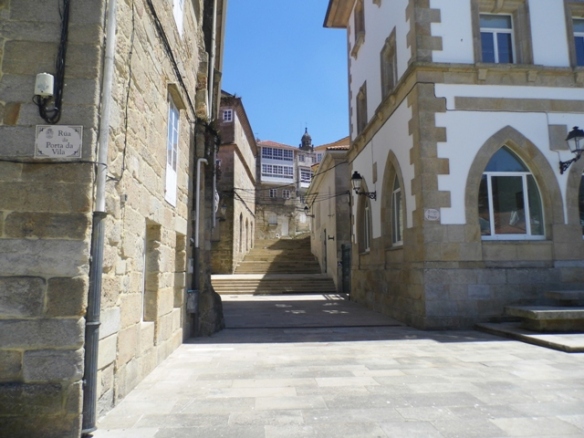
Muros
Tomorrow we will explore the town some more, as I carry on with getting laundry done. My priority at this marina is getting all the bedding washed. We’re all in sleeping bags tonight, as our duvets, sheets and pillowcases are all in various stages of being washed and dried!!
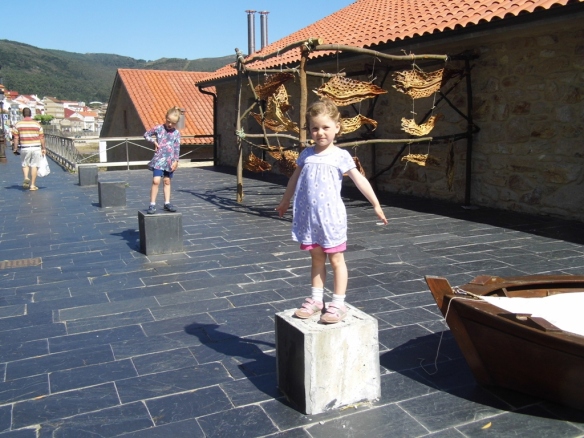 I asked the man at the marina office in Muros what the Spanish word ‘guapa’ means. He laughed, knowing why I asked! He looked at Katie and said, ‘Beautiful’. Since arriving in Spain I hear this word every day as I walk down the street, in shops, in cafes, on country roads. It’s usually spoken by old women who simultaneously tickle Katie or Lily on the tummy, or pinch their cheeks or stroke their hair. Every time they went into the shop in Corme, the shop keeper gave them sweets; the man in the office at Club Nautico de Camariñas gave them each a chocolate bar; an old man in Corme gave them a huge bag of ripe juicy plums from his orchard! At a community feast in Covas, the girls went away to play with some local children. Next thing I saw Katie hand-in-hand with an old woman, who took her to her family’s table to show her off! Guapa, guapa, mas guapa. People laugh and smile and treat them with kindness. I don’t understand much of what they are saying, but the feeling goes beyond language.
I asked the man at the marina office in Muros what the Spanish word ‘guapa’ means. He laughed, knowing why I asked! He looked at Katie and said, ‘Beautiful’. Since arriving in Spain I hear this word every day as I walk down the street, in shops, in cafes, on country roads. It’s usually spoken by old women who simultaneously tickle Katie or Lily on the tummy, or pinch their cheeks or stroke their hair. Every time they went into the shop in Corme, the shop keeper gave them sweets; the man in the office at Club Nautico de Camariñas gave them each a chocolate bar; an old man in Corme gave them a huge bag of ripe juicy plums from his orchard! At a community feast in Covas, the girls went away to play with some local children. Next thing I saw Katie hand-in-hand with an old woman, who took her to her family’s table to show her off! Guapa, guapa, mas guapa. People laugh and smile and treat them with kindness. I don’t understand much of what they are saying, but the feeling goes beyond language.



